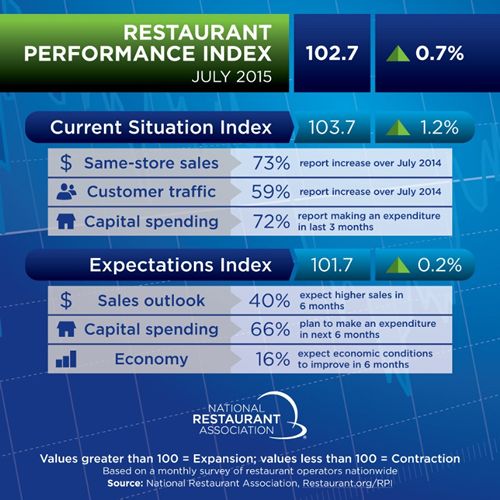Restaurant Industry Added 47K Jobs in January
/Hiring in America slowed down in January, with government data released Friday showing the economy added 151,000 jobs — less than the blockbuster growth of recent months but enough to keep the recovery on solid ground.
The data also showed a 2.5 percent spike in wages over the past year, an encouraging sign that the strength in the labor market might finally be translating into bigger paychecks. The unemployment rate also dipped to 4.9 percent, inching closer to what many economists believe is its lowest sustainable level.
Investors and policymakers are seeking reassurance on the health of the American recovery after the turmoil in global financial markets at the start of the year. Expectations for world economic growth have dimmed, and fears are rising that weakness overseas — particularly in China — could spill over onto U.S. shores.
But Richard Moody, chief economist at Regions Financial Corp., said January’s job growth indicates the slow and steady expansion since the Great Recession remains on track.
“The economy continues to muddle along, even though now and again it’s prone to a misstep,” he said.
Wall Street opened lower on the news Friday. The Standard & Poor’s 500-stock index dropped about 11 points in the first few minutes of trading, about 0.6 percent. The blue-chip Dow Jones Industrial Average fell 54 points, or about 0.3 percent, while the tech-heavy Nasdaq dropped 33 points, or 0.7 percent.
In the final months of 2015, the labor market was roaring, adding an average of 279,000 jobs each month, the fastest pace of the year. Employers went on the hiring spree even as the broader economy slowed to a crawl, dragged down by weak exports and a dropoff in business investment.
But many analysts believe that blockbuster pace is not sustainable. Though January’s job growth fell below Wall Street expectations, economists said a more modest pace was inevitable.
“Amid all the global economic turmoil and domestic market gyrations … [the data] show the U.S. is heading in the right direction,” said Beth Ann Bovino, U.S. chief economist at Standard & Poor’s Rating Service.
Once again, the retail, restaurant and health-care sectors showed the biggest job gains. Retailers added 58,000 jobs in January, while restaurants and bars hired 47,000. The health-care sector expanded by 37,000 positions.
Manufacturing delivered the biggest surprise, adding 29,000 jobs after almost no change during 2015. The industry has been hammered as a stronger dollar dampens international demand for U.S. goods, and plunging oil prices led to mass layoffs. The transportation sector shed 20,000 jobs in January after strong seasonal hiring the previous month.
But the data showed little change for several of the most distressed corners of the job market. About 2.1 million people have been out of work for six months or longer, about the same number as in June. Another 6 million have part-time jobs but would prefer full-time work. Hundreds of thousands have become so discouraged by their job prospects that they’ve stopped looking.
One key measure did show some improvement: The size of the workforce increased slightly, nudging the participation rate up to 62.7 percent after falling to the lowest level in a generation last year.
“Job creation and wage growth need to be far stronger, and they need to remain strong for a longer period of time, before the economy is close to full employment,” said Elise Gould, senior economist at the left-leaning Economic Policy Institute.
The recovery in the labor market from the depths of the Great Recession was one of the key drivers of the Federal Reserve’s decision to raise interest rates in December for the first time in nearly a decade. The move was intended to be a sign of the central bank’s faith in the health of the U.S. economy, and the Fed expected to slowly withdraw its historic support for the recovery over the next few years.
In addition, the strong dollar and low energy prices have pushed inflation well below the Fed’s target of 2 percent, the level generally associated with a healthy economy.
“Risks are tilted to the downside — it is still easier to see the [Fed] slowing down the rate of increases then speeding them up,” wrote Goldman Sachs economists Jan Hatzius and Zach Pandl, who have predicted the central bank will increase the rate three times this year.
But some Fed officials have cautioned against overreacting to movements in the market. In a speech Thursday evening, Cleveland Fed President Loretta Mester said she believes the economy remains fundamentally sound.
“Until we see further evidence to the contrary, my expectation is that the U.S economy will work through the latest episode of market turbulence and soft patch to regain its footing for moderate growth,” she said.
(via The Washington Post)






